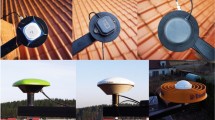Abstract
For over 40 years, NASA’s global network of satellite laser ranging (SLR) stations has provided a significant percentage of the global orbital data used to define the International Terrestrial Reference Frame (ITRF). The current NASA legacy network is reaching its end-of-life and a new generation of systems must be ready to take its place. Scientific demands of sub-millimeter precision ranging and the ever-increasing number of tracking targets give aggressive performance requirements to this new generation of systems. Using lessons learned from the legacy systems and the successful development of a prototype station, a new network of SLR stations, called the Space Geodesy Satellite Laser Ranging (SGSLR) systems, is being developed. These will be the state-of-the-art SLR component of NASA’s Space Geodesy Project. Each of SGSLR’s nine subsystems has been designed to produce a robust, kilohertz laser ranging system with 24/7 operational capability and with minimal human intervention. SGSLR’s data must support the aggressive goals of the Global Geodetic Observing System, which are 1 millimeter (mm) position accuracy and 0.1 mm per year stability of the ITRF. This paper will describe the major requirements and accompanying design of the new SGSLR systems, how the systems will be tested, and the expected system performance.








Similar content being viewed by others
References
Appleby G, Rodríguez J, Altamimi Z (2016) Assessment of the accuracy of global geodetic satellite laser ranging observations and estimated impact on ITRF scale: estimation of systematic errors in LAGEOS observations 1993–2014. J Geod. https://doi.org/10.1007/s00190-016-0929-2
Committee on the Decadal Survey for Earth Science, and Applications from Space (2007) Earth science and applications from space: national imperatives for the next decade and beyond. National Academies Press, Washington
Degnan J (1993) Millimeter accuracy satellite laser ranging, contributions of space geodesy to geodynamics: technology. Geodynamics 25:133–162
Degnan J (2016) An upgraded SGSLR link analysis which includes the effects of atmospheric scintillation and target speckle. In: Proceedings 20th ILRS workshop, Potsdam, Germany, October 2016
Degnan J (2017) Challenges to achieving millimeter accuracy normal points in conventional multiphoton and kHz single photon SLR systems. ILRS technical workshop, Riga, Latvia, October 2017
Degnan J, Machan R, Leventhal E, Reed D, Marzouk J (2016) Progress on the multifunctional range receiver for SGSLR. In: Proceedings 20th ILRS workshop, Potsdam Germany, October 2016
Gross R, Beutler G, Plag HP (2009) Integrated scientific and societal user requirements and functional specifications for the GGOS. In: Plag HP, Pearlman M (eds) Global geodetic observing system. Springer, Berlin. https://doi.org/10.1007/978-3-642-02687-4_7
McGarry J, Merkowitz S, Donovan H, Horvath J et al (2013) The collocation of NGSLR with MOBLAS-7 and the future of NASA satellite laser ranging. In: Proceedings 18th ILRS workshop, Fujiyoshida, Japan, November 2013
McGarry J, Merkowitz S, Shappirio M et al (2014) Developing and deploying NASA’s space geodesy satellite laser ranging systems. In: Proceedings 19th ILRS workshop, Annapolis, Maryland, USA, October 2014
McGarry J, Donovan H, Horvath J et al (2017) Plans for a fully automated SGSLR system. In: ILRS technical workshop, Riga, Latvia, October 2017
Merkowitz S, Esper J, Hilliard L et al (2016) The NASA space geodesy network. In: Proceedings 20th ILRS workshop, Potsdam, Germany, October 2016
Merkowitz S, Bolotin S, Elosegui P et al (2018) The NASA space geodesy network. J Geod Spec Issue Laser Ranging (submitted)
Pavlis EC (2008) SLR and global reference frames over the next decade (INVITED), NAS NRC panel on National requirements for precision geodetic infrastructure, June 11–13, 2008. University of Colorado at Boulder, Boulder, Colorado
Pearlman MR, Degnan JJ, Bosworth JM (2002) The international laser ranging service. Adv Space Res 30(2):135–143
Pearlman MR, Noll CE, Pavlis EC et al (2018) The ILRS: approaching twenty years and planning for the future. J Geod Spec Issue Laser Ranging (submitted)
Sun X, Skillman DR, McGarry JF et al (2013) Time transfer between satellite laser ranging stations via simultaneous laser ranging to the Lunar Reconnaissance Orbiter. In: Proceedings of the 18th international laser ranging service workshop, 13-Po54, Japan 2013
Wilkinson M, Schreiber U, Procházka I et al (2018) The next generation of satellite laser ranging systems. J Geod Spec Issue Laser Ranging (submitted)
Acknowledgements
The authors would like to express their appreciation for NASA Earth Sciences support of this work. We would also like to thank our colleagues for their support of this work and this paper, including Stephen Merkowitz of NASA Goddard Space Flight Center, Roman Machan, Ed Leventhal, Dan Reed, Jim Lyons and Guangjun Gao of Sigma Space Corporation, and Tony Mann, Mike Heinick, Felipe Hall and Earl Daniel of KBRwyle.
Author information
Authors and Affiliations
Corresponding author
Rights and permissions
About this article
Cite this article
McGarry, J.F., Hoffman, E.D., Degnan, J.J. et al. NASA’s satellite laser ranging systems for the twenty-first century. J Geod 93, 2249–2262 (2019). https://doi.org/10.1007/s00190-018-1191-6
Received:
Accepted:
Published:
Issue Date:
DOI: https://doi.org/10.1007/s00190-018-1191-6




